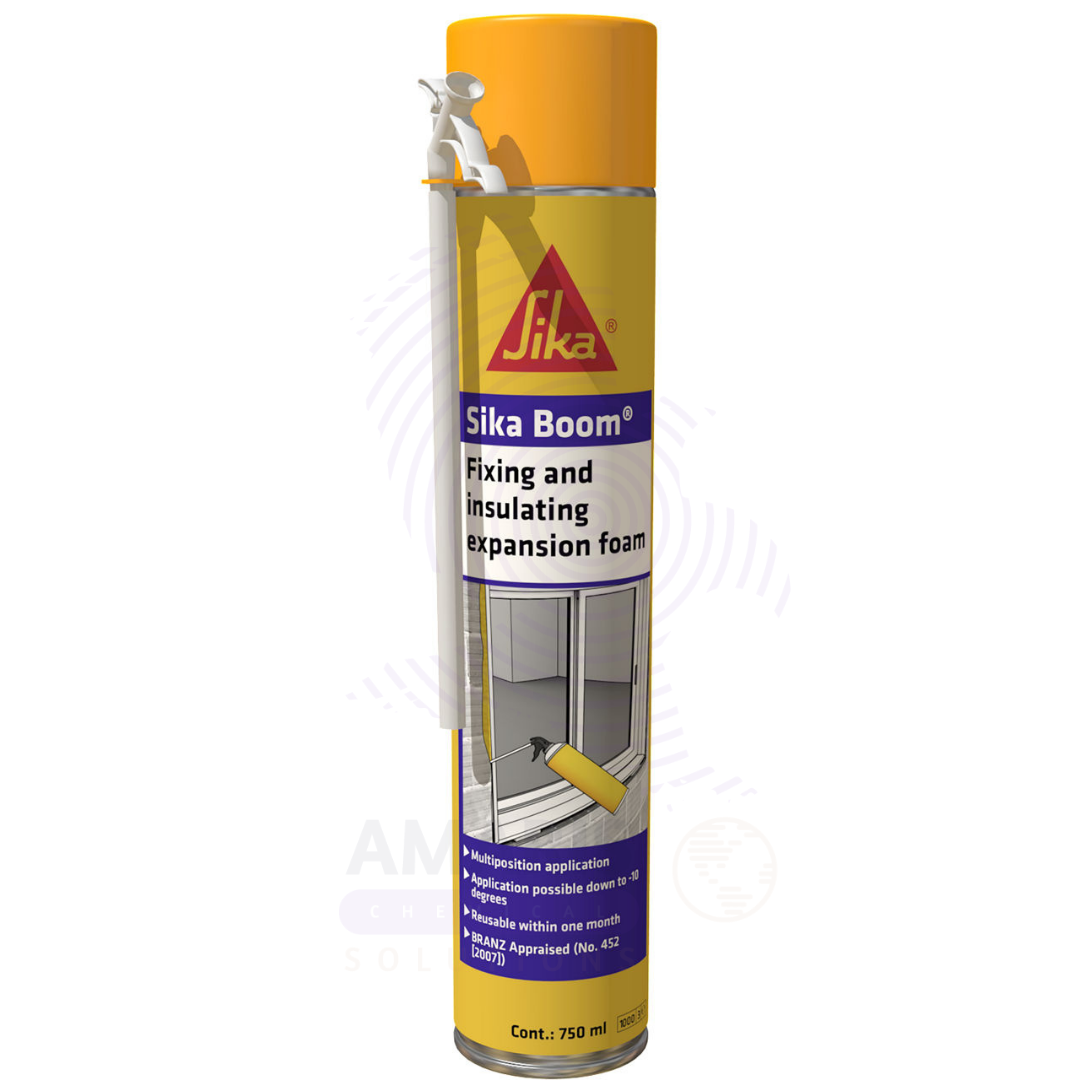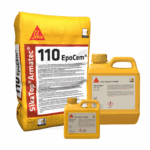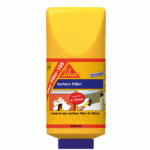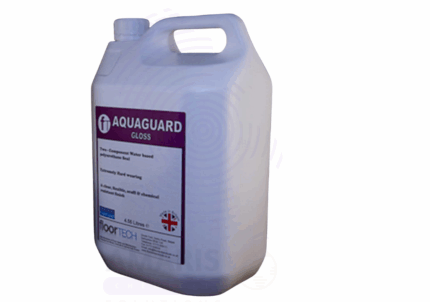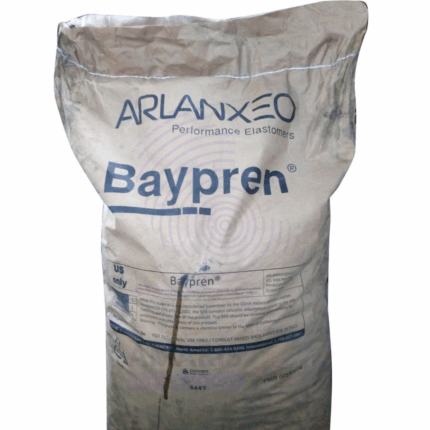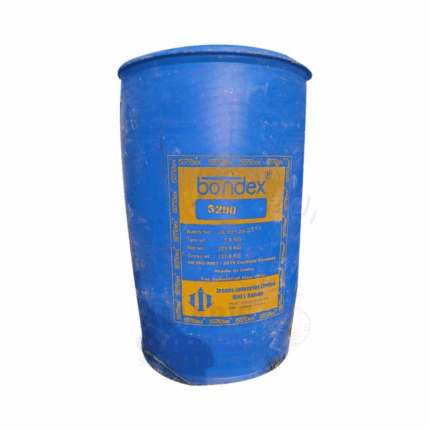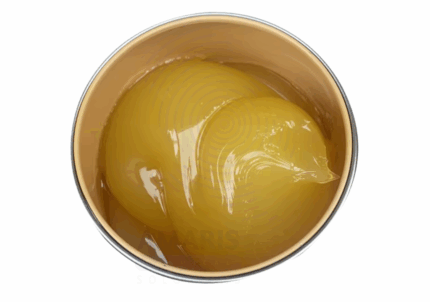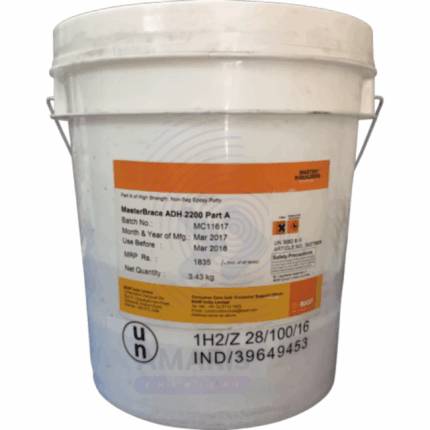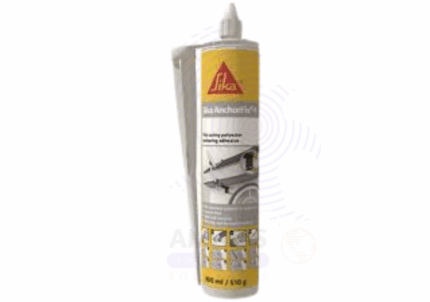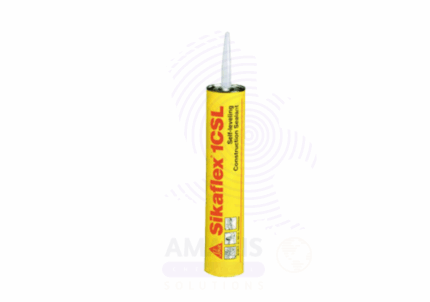Sika Boom Expanding Foam
Whatsapp Order
Sika Boom Expanding Foam is a one-component, polyurethane-based, fast-curing foam designed for sealing, filling, insulating, and bonding applications in construction and renovation. It expands rapidly upon dispensing to fill cavities, gaps, and voids, providing excellent thermal and acoustic insulation. The foam adheres well to most common building materials such as wood, concrete, metal, and plastics. It is moisture-curing and offers good resistance to aging, shrinking, and water.
Description
Table of Contents
Toggle
Sika Boom Expanding Foam
Primary Uses
- Construction and Building
- Sealing gaps, cracks, and joints around windows, doors, and frames to improve insulation and airtightness.
- Filling cavities and voids in walls, ceilings, and floors to enhance thermal and sound insulation.
- Bonding lightweight panels and insulating materials in interior and exterior applications.
- Preventing drafts and moisture ingress in building envelopes.
- HVAC Industry
- Insulating and sealing ductwork connections and penetrations to improve system efficiency.
Secondary Uses
- Plumbing and Electrical
- Sealing around pipes and cables passing through walls and floors to prevent air and water leaks.
- DIY and Home Improvement
- General-purpose filler and adhesive for minor repairs and renovations.
- Packaging
- Cushioning and protecting fragile items during transport by filling voids inside packaging.
KEY PRODUCT FEATURES
1. Basic Identification Attributes
- Chemical Name (IUPAC): Polyurethane prepolymer-based foam
- Common/Trade Name: Sika Boom Expanding Foam
- CAS Number: Proprietary formulation
- HS Code: 3909.50 (Polyurethane foams)
- Synonyms: PU expanding foam, one-component foam sealant
2. Physical & Chemical Properties
- Physical State: Aerosol foam
- Color & Odor: Off-white to cream; characteristic polyurethane odor
- Density: Approx. 20–30 kg/m³ (cured foam)
- Expansion Rate: Up to 30 times original volume
- Curing Time: Tack-free in 10–20 minutes; fully cured in 1–4 hours depending on conditions
- Solubility: Insoluble in water once cured
3. Safety & Hazard Attributes
- GHS Classification: Flammable aerosol; irritant to skin and eyes; respiratory sensitizer
- Toxicity: Moderate; avoid inhalation and skin contact
- Exposure Limits: Follow local occupational safety guidelines
4. Storage & Handling Attributes
- Storage Conditions: Store in a cool, dry place away from direct sunlight and heat sources
- Container Type: 750ml pressurized aerosol can
- Shelf Life: Typically 12 months if stored unopened and properly
- Handling Precautions: Use gloves and eye protection; ensure good ventilation; keep away from ignition sources
5. Regulatory & Compliance Attributes
- Complies with EU regulations on construction products (CE marked)
- Meets VOC limits for construction sealants and foams
- Registered under relevant environmental and safety regulations
- Complies with transportation regulations for aerosols (UN 1950)
6. Environmental & Health Impact
- Biodegradability: Not biodegradable; inert once cured
- Ecotoxicity: Low once cured; uncured foam hazardous to aquatic life
- Bioaccumulation: Not significant
SAFETY HANDLING PRECAUTIONS
Safety Handling Precautions
- PPE Required: Gloves, safety goggles, and protective clothing recommended
- Handling Guidelines: Avoid inhalation of vapors; apply in well-ventilated areas; avoid contact with skin and eyes
- Storage Measures: Keep canisters tightly closed; store away from heat and open flames
First Aid Measures
- Inhalation: Move to fresh air; seek medical attention if breathing difficulties occur
- Skin Contact: Wash with soap and water; remove contaminated clothing; seek medical advice if irritation develops
- Eye Contact: Rinse with plenty of water for at least 15 minutes; seek immediate medical attention
- Ingestion: Do not induce vomiting; seek medical help immediately
Firefighting Measures
- Fire Hazards: Flammable aerosol; container may burst when heated
- Extinguishing Media: Use foam, dry chemical, CO₂, or water spray
- Special Precautions: Wear full protective clothing and self-contained breathing apparatus
- Hazardous Combustion Products: Carbon oxides, nitrogen oxides, and isocyanates
Related products
Aquaguard
Aquaguard is a brand name commonly associated with water purification products and filtration systems designed to provide safe, clean drinking water. These systems typically use technologies such as UV purification, RO (reverse osmosis), UF (ultrafiltration), and activated carbon filters to remove contaminants including bacteria, viruses, dissolved salts, heavy metals, and suspended particles. Aquaguard products are widely used in residential, commercial, and industrial settings to improve water quality, taste, and safety. The brand encompasses water purifiers, filters, and treatment units tailored to different water sources and purity requirements.
Bayprene
Bayprene is a high-quality, synthetic rubber polymer belonging to the class of nitrile butadiene rubbers (NBR). It is widely used for its excellent resistance to oils, fuels, chemicals, and abrasion, making it ideal for sealing, gasketing, hoses, and industrial applications where durability and chemical resistance are required. Bayprene exhibits good mechanical properties, high tensile strength, and resistance to swelling and degradation, especially in petroleum-based environments. It is commonly supplied as solid rubber sheets, molded parts, or raw polymer for compounding.
Bondex 5299
Bondex 5299 is a solvent-based, high-performance industrial adhesive formulated to provide strong, durable bonds on a wide variety of substrates such as metals, plastics, rubber, and composites. It appears as a clear to amber viscous liquid with a characteristic solvent odor. Known for excellent resistance to heat, moisture, and chemicals, Bondex 5299 cures by solvent evaporation to form a flexible, resilient bond. It is widely used in automotive, aerospace, electronics, and heavy machinery industries due to its reliable bonding strength and quick curing properties.
Magpow Silicone Sealant
Magpow Silicone Sealant is a one-component, moisture-curing silicone-based sealant formulated for high-performance sealing, bonding, and insulating applications. It cures at room temperature when exposed to air moisture, forming a durable, flexible rubber-like elastomer. It adheres well to glass, metal, ceramic, plastic, and many construction materials. Commonly used in general construction, glazing, automotive, and household repair applications, Magpow Silicone Sealant offers excellent resistance to weathering, UV radiation, moisture, and temperature extremes.
Marble Adhesive Glue
Marble Adhesive Glue Granite Glue, also known as Granite Glue, is a high-strength adhesive specifically formulated for bonding natural stones such as marble, granite, and other types of stone surfaces. It offers excellent adhesion, durability, and resistance to environmental factors like moisture, heat, and chemicals. This glue is commonly used in construction, interior decoration, and stone fabrication industries to securely fix stone slabs, tiles, and countertops. The adhesive provides a seamless and strong bond, facilitating the installation and repair of stone surfaces with high aesthetic and structural quality.
Master Brace ADH
Master Brace ADH is a high-strength adhesive designed for bonding construction materials such as concrete, metal, wood, and stone. It is formulated to provide superior adhesion, fast curing, and excellent durability, making it suitable for both indoor and outdoor applications. The adhesive offers resistance to moisture, temperature variations, and mechanical stress, ensuring long-lasting bonds in demanding construction environments.
Sika Anchorfix 1
Sika Anchorfix 1 is a high-performance, two-component, fast-curing adhesive mortar designed for anchoring and fixing applications in concrete and masonry. It provides superior bond strength, chemical resistance, and durability, making it suitable for heavy-duty structural and non-structural fastening tasks. The product is easy to mix and apply, cures rapidly at various temperatures, and complies with international construction standards, ensuring reliable and long-lasting anchoring performance.
sikaflex 1c sl limestone 10oz
sikaflex 1c sl limestone 10oz is a single-component, self-leveling polyurethane sealant designed for horizontal joints in concrete and other construction materials. The “Limestone” refers to its color, and the 10oz packaging is typically in cartridge form for convenient use. It cures with atmospheric moisture to form a flexible and durable seal. This sealant offers excellent adhesion, weather resistance, and movement capability, making it ideal for both commercial and industrial applications where horizontal sealing is required.


 Preservatives(food)
Preservatives(food) Flavor Enhancers
Flavor Enhancers Acidulants
Acidulants Sweeteners
Sweeteners Antioxidants
Antioxidants Colorants(food)
Colorants(food) Nutraceutical Ingredients (food)
Nutraceutical Ingredients (food) Nutrient Supplements
Nutrient Supplements Emulsifiers
Emulsifiers
 Collectors
Collectors Dust Suppressants
Dust Suppressants Explosives and Blasting Agents
Explosives and Blasting Agents Flocculants and Coagulants
Flocculants and Coagulants Frothers
Frothers Leaching Agents
Leaching Agents pH Modifiers
pH Modifiers Precious Metal Extraction Agents
Precious Metal Extraction Agents
 Antioxidants(plastic)
Antioxidants(plastic) Colorants (Pigments, Dyes)
Colorants (Pigments, Dyes) Fillers and Reinforcements
Fillers and Reinforcements Flame Retardants
Flame Retardants Monomers
Monomers Plasticizers
Plasticizers Polymerization Initiators
Polymerization Initiators Stabilizers (UV, Heat)
Stabilizers (UV, Heat)
 Antifoaming Agents
Antifoaming Agents Chelating Agents
Chelating Agents Coagulants and Flocculants
Coagulants and Flocculants Corrosion Inhibitors
Corrosion Inhibitors Disinfectants and Biocides
Disinfectants and Biocides Oxidizing Agents
Oxidizing Agents pH Adjusters
pH Adjusters Scale Inhibitors( water)
Scale Inhibitors( water)
 Antioxidants(cosmetic)
Antioxidants(cosmetic) Emollients
Emollients Fragrances and Essential Oils
Fragrances and Essential Oils Humectants
Humectants Preservatives
Preservatives Surfactants(cosmetic)
Surfactants(cosmetic) Thickeners
Thickeners UV Filters
UV Filters
 Fertilizers
Fertilizers Soil Conditioners
Soil Conditioners Plant Growth Regulators
Plant Growth Regulators Animal Feed Additives
Animal Feed Additives Biostimulants
Biostimulants Pesticides (Herbicides, Insecticides, Fungicides)
Pesticides (Herbicides, Insecticides, Fungicides)
 Active Pharmaceutical Ingredients (APIs)
Active Pharmaceutical Ingredients (APIs) Excipients
Excipients Solvents(pharmaceutical)
Solvents(pharmaceutical) Antibiotics
Antibiotics Antiseptics and Disinfectants
Antiseptics and Disinfectants Vaccine Adjuvants
Vaccine Adjuvants Nutraceutical Ingredients (pharmaceutical)
Nutraceutical Ingredients (pharmaceutical) Analgesics & Antipyretics
Analgesics & Antipyretics
 Analytical Reagents
Analytical Reagents Solvents(lab)
Solvents(lab) Chromatography Chemicals
Chromatography Chemicals Spectroscopy Reagents
Spectroscopy Reagents microbiology-and-cell-culture-reagents
microbiology-and-cell-culture-reagents Molecular Biology Reagents
Molecular Biology Reagents Biochemical Reagents
Biochemical Reagents Inorganic and Organic Standards
Inorganic and Organic Standards Laboratory Safety Chemicals
Laboratory Safety Chemicals Specialty Laboratory Chemicals(Special Laboratory Equipment)
Specialty Laboratory Chemicals(Special Laboratory Equipment)
 Demulsifiers
Demulsifiers Hydraulic Fracturing Fluids
Hydraulic Fracturing Fluids Scale Inhibitors(oil)
Scale Inhibitors(oil) Surfactants(oil)
Surfactants(oil) Drilling Fluids
Drilling Fluids
 Dyes and Pigments
Dyes and Pigments Bleaching Agents
Bleaching Agents Softening Agents
Softening Agents Finishing Agents
Finishing Agents Antistatic Agents
Antistatic Agents
 Admixtures
Admixtures Waterproofing Agents
Waterproofing Agents Sealants and Adhesives
Sealants and Adhesives Curing Compounds
Curing Compounds Concrete Repair Chemicals
Concrete Repair Chemicals Anti-Corrosion Coatings
Anti-Corrosion Coatings
 Surfactants(cleaning)
Surfactants(cleaning) Builders
Builders Enzymes
Enzymes Solvents (Cleaning)
Solvents (Cleaning) Fragrances
Fragrances
 Electronic Chemicals
Electronic Chemicals Catalysts
Catalysts Lubricants
Lubricants Photographic Chemicals
Photographic Chemicals Refrigerants
Refrigerants Automotive chemicals
Automotive chemicals Pyrotechnic Chemicals
Pyrotechnic Chemicals
 Biodegradable Surfactants
Biodegradable Surfactants Bio-based Solvents
Bio-based Solvents Renewable Polymers
Renewable Polymers Carbon Capture Chemicals
Carbon Capture Chemicals Wastewater Treatment Chemicals
Wastewater Treatment Chemicals
 Pigments
Pigments Solvents(paint)
Solvents(paint) Specialty Coatings
Specialty Coatings Binders/Resins
Binders/Resins Additives
Additives Driers
Driers Anti-Corrosion Agents
Anti-Corrosion Agents Functional Coatings
Functional Coatings Application-Specific Coatings
Application-Specific Coatings
 Fresh Herbs
Fresh Herbs Ground Spices
Ground Spices Whole Spices
Whole Spices Spice Blends
Spice Blends Dried Herbs
Dried Herbs
 Leavening Agents
Leavening Agents Dough Conditioners
Dough Conditioners Flour Treatments
Flour Treatments Fat Replacers
Fat Replacers Decoratives
Decoratives Preservatives(baking)
Preservatives(baking)
 Plasticizers & Softeners
Plasticizers & Softeners Reinforcing Agents
Reinforcing Agents Adhesion Promoters
Adhesion Promoters Vulcanizing Agents
Vulcanizing Agents Antidegradants
Antidegradants Blowing Agents
Blowing Agents Fillers & Extenders
Fillers & Extenders Accelerators & Retarders
Accelerators & Retarders